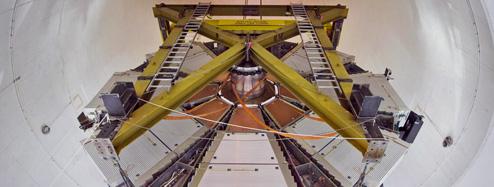
Thanks to the contribution by TRIUMF, Canada's national laboratory for particle and nuclear physics located in Vancouver, BC, Canadians can celebrate their role in placing the final piece of equipment in a mammoth machine begun over nine years ago: The ATLAS detector at the Large Hadron Collider (LHC). The first piece of ATLAS was installed in 2003. Thousands more pieces journeyed down the 100-metre shaft into the ATLAS underground cavern. Today, February 29th, the last piece of this gigantic puzzle was put into place. (see banner photo)
Known as the “small wheel,” this final element of the ATLAS muon spectrometer is 9.3 metres in diameter and weighs 100 tonnes. The entire detector system contains an area equal to three football fields and contains 1.2 million independent particle detectors. As particles produced by CERN’s LHC pass through a magnetic field produced by gigantic superconducting magnets, this detector has the ability to track their paths to an accuracy of a fraction of a millimeter, thus measuring their direction and energy.
The LHC is a product of the efforts of thousands of scientists and engineers from 178 institutions in 35 countries and regions involved in a worldwide collaboration to complete the flagship particle accelerator at CERN, the European Organization for Nuclear Research. TRIUMF brought together the expertise of over a hundred Canadian physicists who contributed to the ATLAS detector, a 46-metre long, 25-metre high, 7000-tonne detector central to the workings of the LHC accelerator. ATLAS is a particle physics experiment that will explore the fundamental nature of matter and the basic forces that shape our universe.
TRIUMF’s participation via in-kind support of scientific staff and equipment in this international effort is a tremendous opportunity for fundamental physics research in Canada. TRIUMF will also be a hub for data analysis from the experiment, facilitating access cutting-edge physics research for Canadian universities.
For more information, please read the full press release.
by Timothy Meyer
TRIUMF's Head of Strategic Planning and Communications
Photos Courtesy CERN.
